
Publisher:
Bonnie King
CONTACT:
Newsroom@Salem-news.com
Advertising:
Adsales@Salem-news.com

~Truth~
~Justice~
~Peace~
TJP
Jan-13-2009 15:08

 TweetFollow @OregonNews
TweetFollow @OregonNews
Islas Malvinas Day in Argentina
Eddie Zawaski Salem-News.comHoly week would be a crowded and noisy salute to the last of summer’s heat, but we were able to endure until Easter, the return of rain and peace at last.
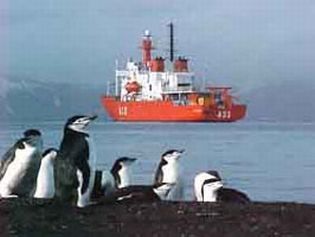 Photo courtesy: argentinaoutdoors.com |
(FALKLAND ISLANDS, Argentina) - Islas Malvinas Day came and went. A thief in the night, it hid itself at the beginning of la semana santa (holy week) and managed to stay unnoticed in the shadows of the grander holidays that would follow. There were no conspicuous displays of Argentine flags, parades, fireworks or other conventional displays of patriotic fervor.
 In el Bolson, the only inkling we had that there was a holiday afoot was that the banks were closed; but in a town with only two banks that stay open only three hours per day, most closures go by unnoticed. The 24-hour teller machines did a nonetheless brisk business.
In el Bolson, the only inkling we had that there was a holiday afoot was that the banks were closed; but in a town with only two banks that stay open only three hours per day, most closures go by unnoticed. The 24-hour teller machines did a nonetheless brisk business.
The Diebold Corporation does not cry for Argentina’s loss at the hands of Margaret Thatcher’s Navy. The used bookseller with her rickety card-tables of pulp novels that she sells in front of the library was the sole observant, sporting a banner announcing the sale of Malvinas memorial calendars.
Indignant patriots blamed the government for the fizzling of their holiday. It seems that the commemoration had been moved from another date and placed on April 2nd to coincide with the date that Argentina’s “liberation” of the Malvinas began in 1982.
Well-meaning politicians had hoped that having the Malvinas holiday serve as a kick-off to this year’s Easter celebration would help make it a more upbeat and brighter holiday. After all, Holy Week is Argentina’s equivalent of Labor Day in the US, a grand finale to summer that includes a full week of family vacation and endless barbecue. With half the country in a party mood, on the road headed for their favorite vacation spot, there could be no doubt that the week’s traditional good vibes would spill out onto the Malvinas commemoration. They couldn’t have been more wrong. The specter of Leoplodo Galuteri, the evil military dictator who launched the April 2nd attack to rescue his faltering grip on power, cast a pall over the day.
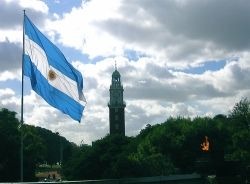 The Argentine Flag, the Clock Tower from |
Adding insult to injury, torrential downpours struck all the northern mountain resorts and swamped southern Patagonia as well. Islas Malvinas Day was not meant to be.
The current neo-socialist Peronist government of Nestor Kirchner has been trying to whip up its own variety of nationalist frenzy over the Malvinas with mixed success. While nearly all Argentines of all political persuasions have a deep soft spot for the windswept Atlantic rocks that the British call the Falklands, few are moved to actually do anything about the “lost province.” The government cancelled some unused oil leases and the people declined to remove the remains of fallen relatives in an island cemetery.
It’s as if Argentina declared its dedication to the Malvinas in a fit of inaction. All the speechmaking and news broadcasting around these non-events has, however, gained the attention of the international press. While the rest of the world witnesses the awakening of belligerent nationalism, Argentines go on about their business safe in the knowledge that they have about as much chance of reclaiming the islands as Mexico has of reclaiming California. Besides, the week brought some more local and passionate political issues to the fore.
The Neuquen teacher’s strike turned bloody. Neuquen is a vast inland province that straddles the border between the fertile southern Pampa and the northernmost reaches of the great Patagonian desert. Halfway on its course from the Andes to the Atlantic, the Rio Negro passes through the urban heartland of Neuquen Province, the twin cities of Neuquen and Cipoletti.
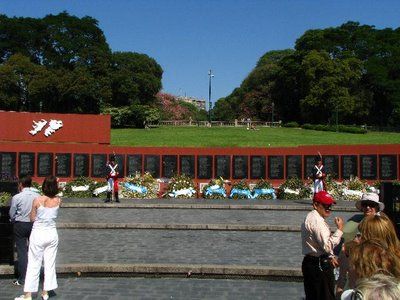 The Malvinas War Memorial in Argentina. Courtesy: bp1.blogger.com |
These cities and the string of communities that stretch for 50 miles up and downstream were all built on the commerce that comes with growing fruit in a well-irrigated semi-arid region. Agricultural prosperity is, however, a hard fought low-profit kind of success that provides basic living needs for those who wrestle the land and little else. Thus the string of metropolis that fill this fruit laden valley are also filled with hardscrabble folk.
By the end of March, the apples, plums, and pears had all been harvested and thousands of the regions youngsters were back in school. When, however, Holy Week arrived, the teachers went out on strike. It seemed like a good time to call a halt to work as a way of signaling the teachers’ disaffection for the corrosive effects of inflation on their salaries.
With three days already taken out of the week for various holidays, not many school days would be lost. Moreover, the teachers could gain significant attention for their plight by employing the traditional Argentine tactic of “cortando la ruta”, setting up a blockade on a major highway that would have the effect of cutting off tourists from reaching their holiday destinations. It took only one day of hotel cancellations in Bariloche before the Neuquen police came out to try to break the blockade.
Tragedy struck during a tear-gas attack on a chanting crowd of teachers and a few students. Instead of firing his tear gas canister onto neutral ground in front of protesters, one over-eager officer fired his can directly into the open window of a passing car. When the can burst apart on the chest of the 41-year old teacher who was driving the car, flying shards of metal and toxic gas overcame the driver instantly and sent him and his car immediately into a roadside ditch. The teacher was pronounced DOA when his body arrived at the hospital.
After this, the issues changed. Police brutality replaced low wages as the primary issue. Roadside protests grew instantly as angry crowds accused the police of planning the murder of an innocent citizen demonstrating for his rights and welfare. Intentional or not, the so-called tear gas murder had the effect of putting the teachers in the driver’s seat as far as their strike was concerned. The strike committee issued communiqués announcing hours when the blockade would be lifted to allow tourists to return home and denouncing the murderous collusion of police and provincial government officials.
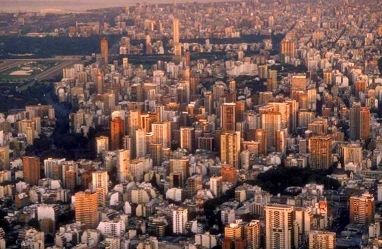 Buenos Aires Argentina from the air. Courtesy: estes.tn.org |
In far away Buenos Aires, the national teacher’s union announced a one-day memorial strike for their fallen Neuquen colleague as the entire nation focused on the strike and enjoyed an extra day to the already too long holiday week. Tourists on the road back to Buenos Aires from their sojourns in Chubut and points south in Patagonia began to hole up in El Bolson and Bariloche, waiting for the blockade to break at the weekend.
Friday and Saturday of Holy week saw a fever pitch of crowds in El Bolson. Every hosteria and hospedaje overflowed and a walk through the town’s hippy feria took the better part of an afternoon in shoulder-to-shoulder closeness. Even the locals who make their living from the tourist trade thought that it was too much of a good thing.
For our part, it would have been a good week to get out of town ourselves, but the whole region is so packed with vacationers there is literally nowhere to go. Anyone who has ever decided on a last-minute camping excursion on a Labor Day weekend knows the feeling. Even with a full tank of gas and the best maps of the most remote places, there is no place to go. We couldn’t even sign up for a tour as the tour trips were all booked up. We were glad we had taken our tour the previous week.
The week that straddled the end of March and the onset of April was as summery as it could possibly be. The sun would emerge late every morning from behind our mountain, but then work hard to blaze away the brisk, almost biting morning air. By mid-afternoon, the fields and forests that had seen no rain for over a month wavered softly in the gentle heat. Such dry but short days with only moderate heat would be perfect for getting out onto the desert. We booked an excursion to Maiten and a ride on the Old Patagonian Railway.
We could have done without the tour guide commentary. As we settled into the seats on our minibus for the 90 minute ride to Maiten and the edge of the great desert, our tour guide, Javier, strapped on his mike and headset to begin his narration of the trip. From door to door, he would talk non-stop as he drove with so much to say that he had to take several stops along the way to get all the details in. He had details. We learned the names of every shrub and tree and the elevation of every town and lake. He gave a capsule history of every little community we passed through as well as a litany of its economic contributions to the regional economy. He had just as much to say on flat barren scrubland as he did in green mountain hills and valleys.
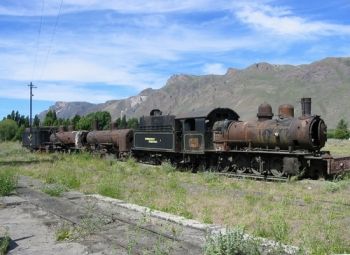 Old train at La Trochita, Argentina. Courtesy: panoramio.com |
I wished that I knew less Spanish so I could fade off and let his voice float through my head as so many meaningless syllables, but it was not meant to be. I will forever remember that the Maiten tree likes yearly rainfall between 10 and 30 centimeters and is the only reliable source of shade on long hot summer days in Patagonia. It was with great relief that we debarked the bus in El Maiten at the rickety old railroad station.
El Maiten is perhaps only 20 miles east of El Bolson and El Hoyo, but it is a universe away in terms of climate. Lying just 15 miles out on the plain from the nearest Andean peaks, this dusty settlement seems ten times drier and ten times more isolated than its cousins on the west side of Cerro Piltriquitron. Many of the houses built by the original settlers remain here. They are rough square-logged cabins, no-nonsense pillboxes against the bitter desert winds and heat.
There were a few modern Andean rustic cedar and brick homes, but for the most part log and simple adobe dominated here. The town had one paved street that ran for about four blocks with a small park at either end. The few Chevy pick-ups and Ford Falcons that could be spotted parked in town were not taking advantage of the precious pavement. Any real action in town was at the train station.
The station was a simple wooden platform about 60 meters long that paralleled a set of small tracks that were sinking into the sand. Our bus pulled up alongside several other tour buses that had arrived from Esquel and Trevelin. As the tourists, mostly Argentines but a few Australians and Germans as well, piled out and onto the platform, they were obliged to walk past the miserable displays of the paisano souvenir vendors.
There were rocks of every imaginable size and shape but not much else, what the desert has to offer. With the exception of a few crudely painted mate cups, there was little on their sawhorse tables to tempt even the most profligate trinket collector. We handed five pesos over to some children who were hawking shapeless hunks of quartz. They were delighted when we turned and left before they could find us some change. We were in a hurry to get on board the train.
The train we were about to ride was an original, not a replica, example of the narrow gauge railroads that were built in the nineteenth and early twentieth centuries to populate and serve the vast southern reaches of South America. The engines ran on wood-fired steam boilers lubricated by hot oil. While these locomotives had a primitive appearance, something like oversized oil drums with wheels; they were the most advanced railroad technology of their day, imported from Germany and the US. Our engine with “Viejo Expreso Patagonica” painted on its flank, puffed eagerly as it waited to begin our trip. There was a short car carrying wood behind it and a longer water tanker behind that.
The three passenger cars were made of cipres wood cut and hauled in from the nearby cordillera and had a wood-burning stove at the center of each car. These cars and the dining car that brought up the rear of the train were all quite narrow and small, holding maybe 30 passengers in each and a few more than a dozen for meals. When we tried out the dining car on our return from our trip to nowhere, we were delighted to find that the food was homemade, cheap, delicious and served with great elegance by an eight year old boy. He never spilled a drop of our cafes con leche as he delivered them to us at the back of the rocking and rolling car.
As the train pulled out of the station, through town and onto the desert, another tour guide aurally assaulted us. This time it was a woman who talked faster than our previous guide and was partially drowned out by the creaking of the car and grinding of the metal wheels on the track. Even more fortunately, she had three cars to deliver her spiel to so she left us fairly quickly so we could enjoy the scenery. We did get from her the invaluable information that the train’s top speed was 36 mph.
As we cruised out through desert scrubland on our starboard side, a small herd of horses challenged our speed capabilities by racing the train for nearly a mile. Our equine companions ran easily and joyfully together at just exactly the speed of our train until their leader, a dappled gray stallion, tossed his head suddenly to the right off toward the mesas and they all stopped.
I wondered if it would have been quite as easy for them to keep pace with our 1922 Kassel steam engine with masked desperados on their backs. Surely the gray was descended from one of those brought down here by the hole in the wall gang at the turn of the last century. Chasing trains was in his blood.
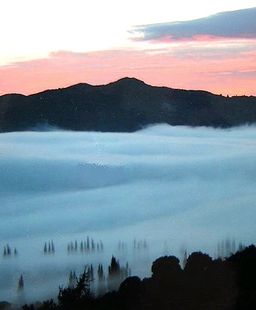 Cholila, Argentina |
Our track followed the upper valley of the Rio Chubut as it wound north and east from its source in the Tres Picos high over Cholila. We rolled along the east side of the valley winding around the feet of a series of mesas covered with sage and innumerable jackrabbits. To the west, the river valley stretched away to reveal the irrigated fields of several large estancias. Waving fields of alfalfa waiting to be cut shimmered against the backdrop of lines of nire trees that marked the river bank and the indigo silhouette of the Andes further off.
As we weaved around these desert mounds, we would hang our heads outside the window of our car to catch a glimpse of the tiny locomotive as it chugged around a bend billowing huge clouds of white steam and wood smoke. Eventually the valley widened, the mesas flattened, and the lush estancias blended back into the desert scrub. At a small pueblo called Norquinco, the Chubut turned sharply east under our track to continue its thousand-mile run down to the southeast and the Atlantic Ocean. We continued on our northbound track for another mile or so where we stopped for our turnaround at the Norquinco station.
Norquinco was little more than a dozen log and adobe buildings. There was a dirt road, the only road, which came into town from the direction of Maiten, but ended there in the pueblo. Only train tracks ventured north from this place. The Nire trees, tall poplars that closely resemble cottonwoods, were ancient and gnarly.
There seemed to be no visible source of water for these giants. If there were any residents in this town, they remained as hidden as the Nire water supply for the only humans to be seen were the train crew and passengers who had all piled out to eat, stretch, and watch the complex turnaround process.
First, the reservoir for the boiler had to be refilled to provide the source of steam for our return trip. This would take about a quarter of an hour of pumping water from the tank car into the reservoir. The engine could make about 50 miles before it needed to be recharged, thus making these periodic watering stops vital to making progress down the line. It was a good thing we had our own water supply in the tank car, as Norquinco looked like it hadn’t seen that much water in several decades.
While the crew transferred the precious substance, the passengers took turns climbing up into the cab of the engine for photo ops. We poked around a bit at the school house, the only building on the east side of the tracks. Like every other building in Norquinco, it looked abandoned or nearly so and the wooden slide in its meager playground may have slid its last child.
We returned to the train to witness the turnaround process. Once the reservoir had been recharged, the train could be turned for the return to El Maiten. There was no roundhouse or length of circular track to change our direction, only a siding. Making use of this siding many times, the crew methodically pulled the engine, tanker, dining and passenger cars back and forth until the positions of each had been reversed on the track.
This process took about a half hour, ultimately concluding with the engine facing backward for its reverse run back to El Maiten. When the conductor pulled the whistle to board, everyone was grateful to leave the dusty heat of Norquinco behind for the shade and breeze of Patagonian rail rambling.
The return trip was enhanced by low afternoon sunlight that caromed off the desert floor and splashed sharply against the distant profile of the cordillera. We sat in the dining car for much of the way eating fresh raspberry pie and gazing out the window across the racing shadow of the train at the stark landscape. Nearing Maiten, we picked up our racing herd of horses again. This time, a chestnut stallion had got a late start behind the crew of usual train chasers. This powerful animal pounded along mightily just outside our window in his vain effort to catch his fellows.
Only when the lead gray made his abrupt turn and stop that nearly bowled over the rest of the gang, did the chestnut manage to catch up. In just a few more minutes we were in Maiten and the train museum.
The museum was not really a museum, but a workshop. There was an actual museum located in the old station building, but for some strange reason it was locked up. We were the only tour that day and probably the only people who would have been interested in going into the museum. Nevertheless, our guide took us through the workshop and explained much of the history of rail travel in Patagonia and detailed the efforts that were now being made to preserve the heritage of the old Patagonian Express. The workshop was cavernous and dark, but the old machinery was kept in good condition.
While there was much lying around that appeared to be unused, a few projects could be discerned to be in progress. At the center was a wooden passenger car, which was being fitted with new pine paneling and floors.
As soon as we completed our tour of the workshop, we were ushered into our van for the trip back to El Bolson. Javier, our guide and driver, strapped his mike back on and began his chatter for the trip back. Once we reached the edge of town, however, he announced that he had said all he had to say and with our permission would continue on without comment.
As we bounced along the dusty dirt track across the scrub and up over the shoulder of Cerro Piltriquitron, I dreamed of chasing the express across the desert on the back of the chestnut, hoping to relieve Banco Rio Negro of its strongbox.
With the romance of having ridden the Old Patagonian Express under our belts, facing the holiday crowds was more manageable.
Each time we had to stand in a long line at the checkout counter at La Anonima, we could imagine that the grisly old gaucho two places ahead of us in line was stocking up for his trip down south to his sheep and rattlesnake infested hideaway.
Holy week would be a crowded and noisy salute to the last of summer’s heat, but we were able to endure until Easter, the return of rain and peace at last.
Articles for January 12, 2009 | Articles for January 13, 2009 | Articles for January 14, 2009

Quick Links
DINING
Willamette UniversityGoudy Commons Cafe
Dine on the Queen
Willamette Queen Sternwheeler
MUST SEE SALEM
Oregon Capitol ToursCapitol History Gateway
Willamette River Ride
Willamette Queen Sternwheeler
Historic Home Tours:
Deepwood Museum
The Bush House
Gaiety Hollow Garden
AUCTIONS - APPRAISALS
Auction Masters & AppraisalsCONSTRUCTION SERVICES
Roofing and ContractingSheridan, Ore.
ONLINE SHOPPING
Special Occasion DressesAdvertise with Salem-News
Contact:AdSales@Salem-News.com

Salem-News.com:
googlec507860f6901db00.html

Terms of Service | Privacy Policy
All comments and messages are approved by people and self promotional links or unacceptable comments are denied.
gp June 20, 2010 8:00 pm (Pacific time)
Owen, the French were there first, they called it Iles Malouines, Falkland was just some British General who came along when England took the Islands by force from the Spanish. Really, you should find out what the First People called it. You owing an appology.
owen lee April 6, 2009 5:38 pm (Pacific time)
we are not called islas malvinas we are called the FALKLAND ISLANDS if think we will change our name they are so ^&%$#@ wrong
Editor: Hey Owen, you can't use language like that here, next time the comment just gets flushed.
gail parker January 14, 2009 4:00 pm (Pacific time)
We don't have rattlesnakes here in Patagonia. It was poetic license I guess that made him refer to the gaucho's rattlesnake infested hideaway.
[Return to Top]©2025 Salem-News.com. All opinions expressed in this article are those of the author and do not necessarily reflect those of Salem-News.com.